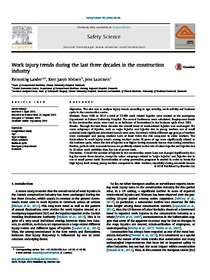Work injury trends during the last three decades in the construction industry

Lander, Flemming ; Nielsen, Kent J. ; Lauritsen, Jens
2016
85
June
60-66
occupational injury ; construction work ; age group ; business cycle ; type of accident
Occupational accidents
https://doi.org/10.1016/j.ssci.2015.10.013
English
Bibliogr.;Charts
"Objectives
The aim was to analyze injury trends according to age, severity, work activity and business cycle in the construction sector.
Methods
From 1980 to 2010 a total of 23.464 work related injuries were treated at the emergency department at Odense University Hospital. The annual incidences were calculated. Employment levels in the construction sector were used as an indicator of fluctuations in the business cycle since 1980.
Results
Through the last three decades the overall trend of work-related injuries was unchanged. For some subgroups of injuries, such as major injuries and injuries due to young workers use of small powered tools significant downward trends were seen, but trends within different age groups of workers were unchanged and young workers have at least twice the risk compared to older workers. The fluctuations in work injury trends among workers under 30 years of age were significantly related to the business cycle, where the risk of injuries was higher during economic booms than during recessions. Further, periods with economic booms are positively related to the rate of minor injuries and injuries due to all other work activities than the use of power tools.
Conclusion
Overall the number of injuries in the construction sector have not changed significantly during the recent three decades, except for minor subgroups related to ‘major injuries' and ‘injuries due to use of small power tools'. Re-evaluation of safety prevention programs is needed in order to break the high injury level among young workers compared to older workers, especially during economic booms."
Digital
The ETUI is co-funded by the European Union. Views and opinions expressed are however those of the author(s) only and do not necessarily reflect those of the European Union or the ETUI.